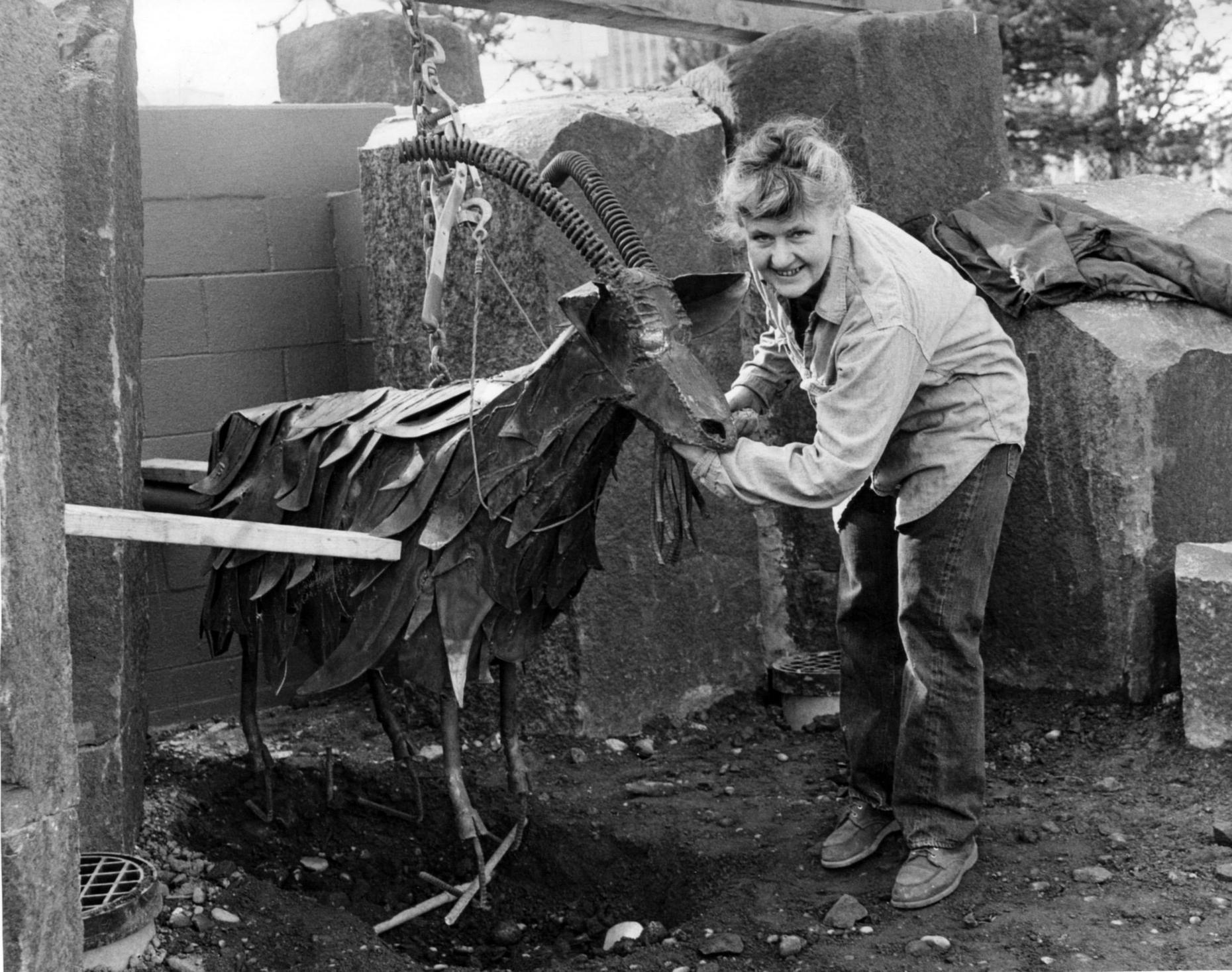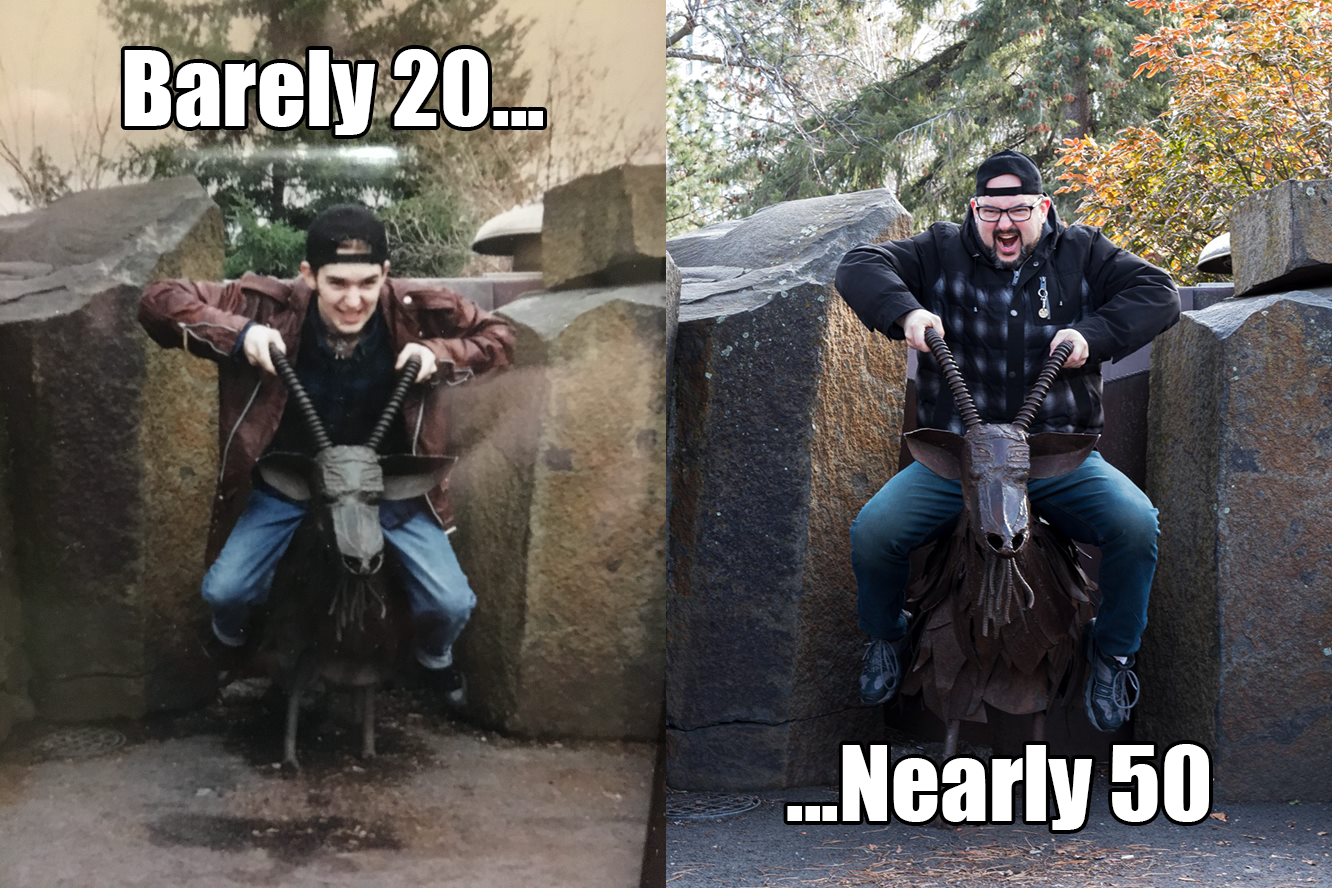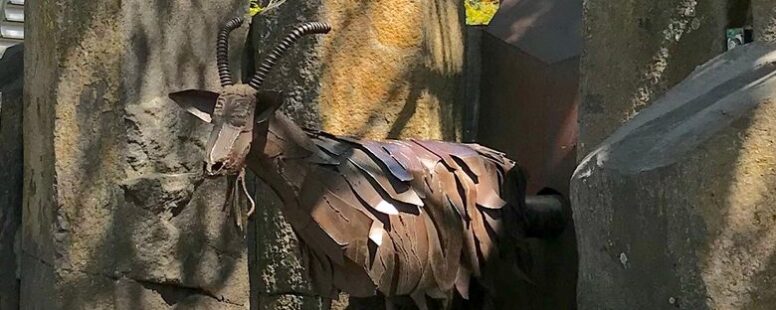Spokane’s Garbage Goat
Podcast: Play in new window | Download | Embed
Subscribe: Apple Podcasts | Spotify | Amazon Music | RSS | More
Installed in 1974, just in time for the World’s Fair Exposition in Spokane, Washington, this iconic structure has delighted children and adults visiting the Inland Northwest for generations—but it isn’t the canted pavilion that once marked the US presence at the fair, or the gondola across Spokane Falls that takes visitors so close they can feel the spray on their faces, or even the German beer garden facility that now houses the 1909 Looff Carrousel (which is on the National Register of Historic Places). No, those destinations in Riverfront Park are amazing remnants of a global event that drew 5,187,826 visitors, including US presidents, foreign dignitaries, and Hollywood stars. Those icons, still in use today, are enthralling…the one we’re talking about, some might say, kind of sucks.
Spokane’s famous Garbage Goat has kept its corner of the park free of debris for nearly 50 years. I happen to have a long relationship with the burnished Bovidae. Growing up in Spokane, we often visited our voracious friend…taking pictures, goofing around, and searching for anything we could possibly find to satiate its never-ending hunger. And when we ran out of trash, nearby leaves and sticks would fall victim to the goat. And sometimes…once in a great while…Spokane’s garbage goat would even suck the mitten right off some poor unsuspecting child’s hand.
To really tell the story right, we have to go back to the early 1960s, when Seattle held its Century 21 World’s Fair exposition in 1962. I’ll cover that story in a future podcast episode for sure, but for now let’s just remember that the fair was a huge success, bringing nearly 10 million people, revitalizing Seattle’s economic and cultural life, and leaving behind the Space Needle, the monorail, several sports venues and performing arts buildings, and—unlike some other world’s fairs of its era—making a profit for the city. By comparison, little old Spokane wasn’t sure it could duplicate the success of its westside counterpart. But hey…if you’re going to dream, dream big!

The theme of the 1974 World’s Fair was Ecology, and every pavilion—from the USSR to the Japanese, the South Koreans to Canada, Australia, Iran, West Germany, and the Philippines—all of them were focused on some sort of environmental theme. And a more fitting location for an environmental fair would be hard to find, what with the natural beauty of the Spokane River cutting right through the middle of the festivities, and the falls creating a constant cacophony of environmental ambiance.
On May 4, 1974, President Richard M. Nixon presided over the opening of Expo ’74, the Spokane World’s Fair. Spokane’s population at that time was about 170,000, making it the smallest city ever to host a world’s fair. When Nixon formally declared the Fair open, officials released 50,000 balloons into the sky (which is funny, given the Fair’s environmental theme. Lord only knows where those ended up; they don’t just vanish, after all).
To make room for the US Pavilion, the iconic structure that still looms large over Riverfront Park today, city officials had to tear down the historic 1902 Great Northern railroad depot on Havermale Island. The only remnant that remained from Spokane’s earliest railroad days is the 155-foot-tall clock tower, which quickly became another beloved piece of Spokane’s downtown skyline.
In the years leading up to the ’74 world’s fair, most of the Spokane community was either dead set against it or totally committed to it. There were very few residents with ambivalent attitudes. One of the more committed members of the community was a Catholic named Sister Paula Mary Turnbull, known to the world as “the welding nun.” Sister Paula was born and raised in Seattle and worked and studied at the University of Washington. She was an art instructor at Holy Names Academy in the 1950s and 60s. Turnbull made a name for herself creating liturgical works for public and private places all over the region. It was Turnbull who conceptualized and created the Garbage-eating goat to teach children not to throw trash on the ground.

In 1972, she was named to the Expo Visual Arts Advisory Committee, which led the effort to install sculptures at the 1974 World’s Fair. Her work to bring more than a dozen quality large-scale art pieces to Riverfront Park to benefit those walking along the river has endured to this day. Sister Paula had recently visited a zoo that had trash cans with animal heads, where kids were encouraged to stuff garbage in the mouths. She apparently thought, if you’re going to have an animal head, why not have the whole animal? When she created the iconic garbage goat, Sister Paula decided that simply shoving trash into an animal mouth was not fun enough and outfitted the goat with a powerful internal vacuum connected to a hidden trash barrel. Visitors press a button on the rock wall next to the goat, listen for the suction, place trash in the palm of their hand, and hold it under the goat’s nose…and FUMP! The trash (or a kids loose-fitting mitten) instantly disappears.
The World’s Fair closed in November 1974, but Garbage Goat remained. The City Parks and Recreation Department kept its electronics and vacuum in good repair and continued emptying the trash barrel. Visitors and residents alike—such as yours truly—would feed the goat, then pose straddling his back, holding his horns like handlebars. And the goat remained ever vigilant over the decades, sucking up trash and patiently posing for goofy photos. In the meantime, Sister Paula continued her prolific welding career, adding more sculptures to Spokane’s artistic inventory.
In addition to a considerable body of religious artwork, Sister Paula’s sculptures around Spokane include a memorial to a man who drowned in a sewage tank at the Riverside Park Water Reclamation Facility, a copper-tube Sasquatch at Spokane Community College, an Irish harp in Riverfront Park’s Connections Garden that plays at the touch of a button, and a miniature Eddie Gaedel (the smallest-ever Major League baseball player) displayed in O’Doherty’s Pub & Irish Grille across the street from the goat, where Sister Paula liked to go for a beer and a Reuben sandwich (one of my own personal favorites).
Of all her public works, Turnbull’s garbage-eating goat that she created for Expo ’74 may be the most memorable. At a 40th birthday party held for the metal farm animal in 2014, the City of Spokane Parks & Recreation Department estimated that the goat had eaten more than 14,000 cubic yards of litter in four decades, while delighting generations of children and their parents. And four years later, the revered Spokane artist and nun who created the Garbage Goat and other iconic sculptures in Spokane and beyond, died at the age of 97. Her longtime friend and fellow renowned Spokane artist, Ken Spiering, said describing what Sister Paula meant to the arts community is nearly impossible. “She was an inspiration to younger artists, helping us understand that we could pursue art as a viable way of life. She led a life of devotion to God, and her devotion to her artwork was also very godly.” Thank you, Sister Paula, for your contributions to Spokane.
“[Sister Paula] was an inspiration to younger artists, helping us understand that we could pursue art as a viable way of life. She led a life of devotion to God, and her devotion to her artwork was also very godly.”
Ken Spiering, Spokane Artist
So where can visitors to Riverfront Park today find our beloved Bovidae? The whole of the park is located on both sides of the Spokane River in downtown. Lying in the middle is Havermale Island, the big one that’s not really an island, and Canada Island (formerly Cannon Island and sometimes known as Crystal Island but renamed during Expo since that’s where the Canadian pavilion was located). On the southern bank of the river, the one closest to the downtown area, visitors will find a large, round building near the corner of Stevens Street and Spokane Falls Boulevard. The former German beer garden during Expo ’74 today houses the historic 1909 Looff Carousel, a Spokane original installed in the long-gone Natatorium Park (another future podcast episode, to be sure) and relocated downtown in 1975 after the closing of the World’s Fair.
Between Stevens Street and the carousel building to the west is a tree-lined asphalt pathway suspiciously absent of any litter to be seen. It is here that you’ll find the basalt column grotto that provides shelter to our honored herbivore. Be sure to bring napkins, Kleenex, receipts, coffee cup sleeves, Halls wrappers, and any other light materials you care to dispose of…because once you feed the famous garbage goat, you will, without a doubt, want to do it again.
Growing up in Spokane, I have many fond memories of the Garbage Goat. Though I was born the year after the world’s fair, I spent many of my teenage years exploring Riverfront Park with my friends, my family, and my cousins on the South Hill. One of my favorite things to do, that I thought was hilarious, was to feed the goat trash through its nostrils. Though the goat has a perpetually open mouth forever waiting to consume trash, but it also has two open nose holes that for some reason entertained me to no end imagining the goat snorting a comically large pile of trash like the end of the movie Scarface.
There are also occasions when I’ve been seen straddling the sculpture, holding its horns like I was riding a goat-shaped motorcycle…

Speaking of blogs, I’ll bet you didn’t know that the Garbage Goat has its own creative outlet on the world wide web. From 2019 to 2020, you could visit garbagegoatblog.wordpress.com to read about “GG” the garbage goat and her (its? her?) take on trash disposal. However, it appears that Spokane County migrated the blog to its own platform. You can now get GG’s advice at spokanecounty.org/Blog.aspx, though it hasn’t seen a new post since January 2022.
There are also some pretty funny reviews of Spokane’s garbage goat on Yelp:
- Louisa M. from Las Vegas, Nevada, gives it five stars saying, “To rate the Garbage Goat anything less than 5 stars seems downright criminal. This was one of my favorite things about Spokane! The goat is exactly what it sounds like: a cool metal billy goat sculpture that you can feed trash! Yes, you take your trash, hold it up to his mouth, and WHOOSH, he sucks up the trash! I think every city needs their own Garbage Goat.”
- Corey G. from West Richland, Washington, gives it four stars saying, “I had no idea about this goat! I thought it was going to be a real goat! What a cool way to get people to not litter. Man, I could use one of these in my kitchen!”
- Christine S. from right here in Spokane says, “Ok, call me dumb, but I *seriously* thought the garbage eating goat people talked of was a REAL goat! It wasn’t until my bf and I were taking a stroll through Riverfront that he took me to the goat and I realized I was mistaken. How is it that I’ve been in Spokane *this* long and never knew it was a metal fabricated goat with a vacuum attached on its [backside]?! Too long! When you describe this goat to people, please don’t make it sound like a *real* goat! I was disappointed that it wasn’t real.”
- Ken L. from Pittsburgh gives it five stars and says, “This was one of the highlights of my short visit to Spokane. I was told during dinner that I would have an opportunity to “feed the goat”. We “turned it on” by pressing the button on the wall and proceeded to feed our newfound friend with paper trash and ripped up newspaper. Apparently after the trash is sucked into the goat it gets transported to a trash can connected to its butt. Bring the kids – it’s just that cool, man.”
- And finally, Cassidy L. from Columbia Falls, Montana, gives it five stars saying, “Famed as the World’s Largest Garbage Eating Goat…I’m pretty sure it’s the world’s only garbage eating goat. I think it’s hilarious to read that most people thought this was a real goat, then realized they came to see a sculpture. Loved by everyone (if you don’t love him, you’re a terrible person).”
Special thanks to Roadside America.com, HistoryLink.org, Wikipedia, and the Spokesman Review newspaper archives for providing background about this terrific topic. Please subscribe to this podcast for new episodes featuring stories from Washington State’s history, heritage, and culture, and follow Washington Our Home on Facebook, Twitter and Instagram, YouTube and Pinterest.
Until next month, I’m your fearless field guide, Erich Ebel, and I’ll see you somewhere in Washington!


Pingback: March – Garbage Goat Riverfront Park – Richy Christmas Card 2024